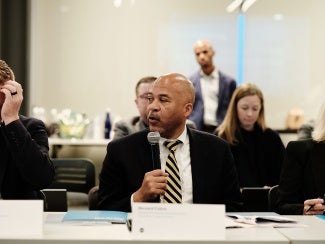AIA Housing Summit seeks solutions to the U.S. housing crisis
AIA convened industry leaders last week to address one of the nation’s most challenging problems.
This year, the median age of a first-time homebuyer in the United States reached a historic high, at 38 years old. For all homebuyers, the median age was even higher: 56.
These statistics reflect just one symptom of a housing market that isn’t working for most Americans. A decade of underbuilding following the Great Recession (causing a shortfall of roughly 4.7 million homes, although some estimates put the number even higher) forms the foundation of the problem—but exacerbating factors, including high mortgage rates and soaring rents, are creating an increasingly untenable situation.
“The time is now to move on all these things,” said Congressman Mike Quigley of Illinois’ 5th Congressional District in an address to a housing summit convened by AIA leadership in Washington, D.C., on Tuesday, Oct. 21. “The threats are great, but for those who are in homeless situations, people who are looking to move out, [and] first-time buyers, [they] recognize that the American dream is just outside their grasp.”
In 2017, AIA's board of directors ratified a member-led resolution, adopted at the Annual Business Meeting, declaring access to housing as a human right. In the time since, AIA’s Housing & Community Development Knowledge Community has worked to advocate for equity in housing. In 2020, the AIA Strategic Council Study Group on Affordable and Equitable Housing issued a report identifying that the demand for affordable, equitable, and climate-resilient housing is rising at a faster rate than the design and construction industry can currently meet.
Last week, AIA's 2025 Housing Summit convened a meeting of industry stakeholders to identify solutions.
“Like many of you, I believe housing is one of the most critical issues facing our profession and our communities,” said AIA 2025 President Evelyn Lee, FAIA, NOMA, during a morning session comprising AIA leadership, members, and staff.
Defining the problem
Throughout the United States, demand for housing is outstripping supply, but additional barriers to housing affordability are plentiful, including zoning and land use restrictions for new construction, permitting delays, and a shortage of federal funding. A 120-city joint survey released earlier this year by AIA and the U.S. Conference of Mayors found that the cost of housing is a major burden on households, with 42% of households spending more than 30% of their income on rent, mortgage payments, and other housing costs.
While increasing the available housing stock in the U.S. would help alleviate the problem, total housing production remains constrained due in part to outdated and lengthy permitting processes.
“Our housing system is stuck,” said Matthew Murphy of NYU’s Furman Center in his keynote address to the summit. “When architects enter this conversation that’s been kind of niche, frankly … I think there’s a lot of power there and a lot of synergy.”
At the local level, Murphy said, cities including Portland, Ore., and Minneapolis have implemented upzoning, legalized gentle density, and changed regulations around infill housing. States such as California, Arizona, and Connecticut now require cities to plan for, and demonstrate capacity for, production of housing at all income levels.
Murphy had ideas on the roles that architects can play in making changes on the policy level, including speaking to development issues with unique credibility and creating feasible housing models based on community needs and market realities.
“The affordability crunch is no longer a coastal issue, which we all know,” Murphy said. “Every community is having this conversation.”
Challenges at the federal level
With budget cuts impacting the Department of Housing and Urban Development and many other federal agencies, multiple attendees of the Housing Summit acknowledged the anxiety and uncertainty around the current federal funding landscape for housing.
“There is no money—that’s the real truth to the situation we are in,” said Dave Gatton, director of the Council of Metro Economies & the New American City at the U.S. Conference of Mayors. He pointed out that the last time the federal government put forth a housing policy with sufficient money behind it was during the Carter administration. “There has been a four-decade-long underfunding of the nation’s housing programs,” he said.
Congressman Quigley also addressed the issue of federal funding in his remarks, stating, “We’re not going to get a lot of help from the federal government in the next couple of years.”
While the U.S.’s Low Income Housing Tax Credit (LIHTC) was expanded under 2025’s One Big Beautiful Bill Act, calling for a permanent 12% credit allocation increase starting in 2026, more financial and regulatory incentives are necessary to encourage the private sector to build more housing, both market-rate and affordable.
“Any supply is good for reducing rents overall,” said Peter Bell, president and CEO of the National Housing & Rehabilitation Association.
A compounding factor on the supply side is the federal government’s restrictive immigration policy, which is adding to an already-significant labor shortage for construction. According to AIA’s Chief Economist, the construction labor force consists of 12 million workers nationally, of which three million are foreign born. One in every eight construction workers are undocumented.
Next steps
One of AIA’s current priorities is support for the bipartisan ROAD to Housing Bill, which recently passed the Senate as part of the National Defense Authorization Act (NDAA). If passed, this legislation would create new, flexible grants to help communities increase housing supply and strengthen infrastructure, among other benefits.
"It’s the most comprehensive federal housing legislation we’ve seen in decades,” said Alexander Cochran, AIA’s chief government affairs officer. “We in the housing community know what we need to do. We need to build more housing now, correctly and quickly. ROAD moves that goal forward. I believe if the housing community joins together we can get it passed in Congress, and the benefits will spread across all who work, build, and rely on safe, affordable and sustainable housing.”
Gatton, of the U.S. Conference of Mayors, emphasized the importance of the summit because of the need for AEC industry and housing stakeholders to work together to meet the current moment.
“We have to take advantage of this [moment], and I think it can only be done in a coalition,” said Gatton, noting that housing production for the country has not been a national issue until now. “I think it’s important … to come together to take advantage of this very rare political moment that we’re in, unfortunately, because we’re in a housing crisis.”
Katherine Flynn is director, digital content at AIA.








